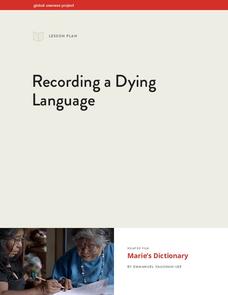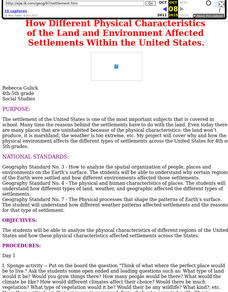Curated OER
Representing Our Nation
Students use pennies to illustrate how our states are represented in Congress. This instructional activity is to be implemented during a unit covering the branches of United States government.
Curated OER
VAcations in Northern California
Students explore the natural resources and National Parks of Northern California that are commonly visited by people traveling in the United States. They use maps to locate various sites, plan a highway travel route and use the internet...
It's About Time
Coal and Your Community
When I was young, I was afraid of the dark. Now I am afraid of getting the electric bill. This fourth lesson in a series of eight focuses on coal mining, conservation, and energy efficiency. Scholars start by taking data from a table and...
It's About Time
Petroleum and Your Community
I was going to write a joke about oil, but it seemed crude. This lesson starts with a comparison of where the US gets oil from and how that has changed over time. After analyzing the data, scholars create a graph and use the Internet to...
Cornell University
Insect Anatomy
Young entomologists discover insect anatomy in a very detailed unit plan. Offering background information for teachers about various insects, class members explore the differences between bugs and insects—and yes, there are many...
Smithsonian Institution
Latino Expression
How much of your daily life is influenced by Latin American music? Take a listen—the answer may surprise you! High schoolers keep a journal to note any instances they see Latino culture represented, including the media, their school, and...
Illustrative Mathematics
Tilt of Earth's Axis and the Four Seasons
Geometry meets earth science as high schoolers investigate the cause and features of the four seasons. The effects of Earth's axis tilt features prominently, along with both the rotation of the earth about the axis and its orbit about...
Smithsonian Institution
African American Music: Let’s Sing and Play Clapping Games
Two lessons focus on making a beat. Using popular African American music of its time, scholars listen and analyze the rhythm then recreate it with hands drums, and cups.
iCivics
County Basics
To understand the concept of a county government system, scholars read a short passage, view a helpful visual aid, use the web to conduct some research about their local areas, and then answer related questions online.
Global Oneness Project
Recording a Dying Langauge
Is there value in preserving indigenous languages that are almost extinct? That's the question posed to viewers of a short film about the attempt of one Native American woman who is creating a dictionary for Wakchumni, the language of...
Curated OER
U.S. and Canada: How are We the Same? How are We Different?
Get high school geographers to compare and contrast Canada and the United States. They begin by drawing a freehand map of North America, then complete readings to gain insight into Canada. The text is not provided; however, another text...
Curated OER
Canada, O Canada
Students study the similarities and differences between Canada and the United State in this unit. They examine geography, government and culture as they "travel" through Canada.
Curated OER
East Asia & The World
Students discuss the relationships between East Asia and the United States. They examine the importance of trade and politics. They examine graphs and charts of certain aspects of the region and discuss.
Curated OER
Images of Our People
Students investigate the history of peoples in the western United States. To accomplish this Students use photographs as images that capture the context of different cultures. Then they write reflections about each culture.
Curated OER
Land and Environment Affected Settlement
Students analyze the physical characteristics of different regions of the United States and how these physical characteristics affected settlements across the States.
Curated OER
Finding River Cities
Using a wall map, students will find major rivers in the four regions of the United States. Then they answer questions about how people use natural resources, such as rivers.
Curated OER
HIV/AIDS and Contemporary Population Dynamics
Students describe the spread and occurrence of HIV/AIDS at multiple scales.
They explain global and regional variations in the occurrence of HIV/AIDS
and the spread of HIV/AIDS in the United States
Curated OER
People On The Move
Pupils describe patterns of internal migration in the United States, past and present and evaluate implications of internal migration. They examine population movement at the state and local levels.
Curated OER
Time for Monet - Timeline Game
This is a game using the artwork of Claude Monet to chronologically arrange events occurring in France and the United States on time lines. Students discuss the probable differences, cause and effect relationships, and similarities,...
Curated OER
Planting Time
Students research crops grown in the United States. In this agriculture lesson, students identify various crops cultivated across the United States as they create charts and maps that note the information.
Curated OER
Comparing Canadian and U.S. Political Systems and Political Campaigns
Students interpret historical evidence presented in primary and secondary resources. In this political systems instructional activity, students conduct research to compare and contrast the forms of government in the ...
Curated OER
U.S. Archaeological Sites: Geography Practice
In this archaeological sites worksheet, students read about sites in the Unites States and use a map to complete a set of 7 short answer questions.
Curated OER
Sociology: What is life like for Gulf Coast rice farmers
Students read 1 page about Gulf Coast rice farmers and then describe what rice farming in the U.S. is like in the United States. In this rice farming lesson plan, students tell why they would or would not want to be a rice farmer.
Curated OER
Temperature Line Graphs
For this temperature worksheet, students create 3 line graphs from data tables showing dates and recorded temperatures. This worksheet includes an answer key.

























